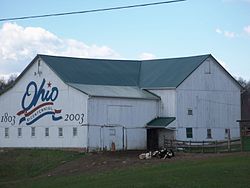

The Ohio Bicentennial was a series of events and programs held in the U.S. state of Ohio to coincide with the 200th anniversary of statehood on March 1, 2003. The Ohio Bicentennial Commission was established by the Ohio General Assembly in 1995 to sponsor commemorative barn paintings, bells, and historical markers throughout the state in the years leading up to the celebration. [1] Other state and federal agencies also marked the anniversary with special events and designations.
